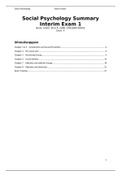Social Psychology Sterre Huizer
Social Psychology Summary
Interim Exam 1
Book: Smith, Eliot R. ISBN: 9781848728943
Druk: 4
Inhoudsopgave
Chapter 1 & 3 – Introduction and Social Perception...............................................................................2
Chapter 4 – The social self......................................................................................................................6
Chapter 5 – Perceiving Groups...............................................................................................................9
Chapter 6 – Social Identity....................................................................................................................14
Chapter 7 – Attitudes and attitude change...........................................................................................18
Chapter 8 – Attitudes and behaviour....................................................................................................22
Exam Training.......................................................................................................................................27
1
,Social Psychology Sterre Huizer
Chapter 1 & 3 – Introduction and Social Perception
Social psychology: studies the interaction between man and (social behaviour.
How does the environment influence our thoughts, emotions and behaviour?
How do our thought, emotions and behaviour influence the environment?
The Nazi personality: how could the world war 2 exist.
Authoritarian: are the people mindless in how they follow up? Is this specific for
these people? Their culture? Lack of empathy? Personality?
Obedient
Lack of empathy
This was not satisfying. Milgram experiment: electrical shocks. Personality is not the most
influential but the social context is the main factor. Potentially we all behave in a similar
way, depending on our social environment.
Themes in social psychology: identity,
group dynamics, attitudes, emotions,
motivation etc.
Social psychology is the scientific study of
the effects of social and cognitive processes
on the way individuals perceive, influence,
and relate to each other.
Person influences social
environment: we construct our social
reality by thinking, psychological
functioning, talk about each other etc.
Social environment influences the person as
well: influence of social reality on individuals.
Useful ways in which they interact:
Motivational principles:
o Mastery: if I decide this > this will
happen (you want to be accurate in your
beliefs so that it will predict certain
outcomes). Example: studying properly
for your exam > understanding the
material > having good grades
o Connectedness: you want to belong to
a social group > more sensitive to a
social group. Talking to a person from a
certain group your also part of, you will
believe what he is saying.
o Valuing me and mine: having a positive view of yourself and in our social
group.
Processing principles:
o Conservatism: tend to stick to our initial impression, less likely to change
our views. Zwarte piet is a part of a children’s party, your less inclined to
change this view if other people have a different view (racism), you’ve
always believed zwarte piet is a good guy.
o Accessibility: not how relevant information is, but more influenced by
information that is accessible. Easily accessible? Easier processed!
o Superficiality vs. depth: asking more questions > processing in depth.
Trying to be accurate or not.
Hot topics are important, just like popular convictions and class studies.
2
, Social Psychology Sterre Huizer
Questions you should ask yourself while studying
First impressions
Associations guide further interpretation
Following different initial information about
a guest speaker (warm vs. cold),
corresponding differences in evaluations
didactic skills were made.
First impressions are informative
Reactions to random 30sec images of
teacher in action correlates strongly with
final evaluation of course.
But not always unequivocal (without
doubt) results
Weak positive correlation between teacher evaluation after 5 minutes and
evaluation at the end of 16 week course
Cues, What information do we use to create an image? – We quickly form a
first impression based on someone’s physical appearance, behaviour and (virtual)
environment
Physical appearance. Video about why the boss hired someone.
‘What is beautiful is good’ heuristic. > We attribute more positive qualities to
attractive people:
Attractive students are seen as more intelligent
Attractive men are attributed higher status
Attractive suspects get short prison sentences. Why? > a third variable
plays a role: socially economic status (more money more connections). This
influences how likely we are to commit a crime.
Heuristic mainly influences general evaluations and judgements on social and
intellectual competence. We associate beautiful with other categories >
intelligence, kind, competent e.g.
We associate dominance with masculine/feminine.
We attribute more masculine (vs. feminine) faces to dominance
Men with a baby face are seen as more naïve, honest, nice and warm
Starting salary of men longer than 1m90 is 10% higher
More atypical faces are rated as less reliable
Contextual factors:
Attractive men are seen as more competent
Attractive woman are not: they will have been selected on appearance
Critical on these findings: (causal relations, what people perceive is not objectively
the case > constructing your own environment) Example physical appearance on
how hot the professor is. Correlation between perceived hotness and the expertise
of the teacher/learning outcomes. Criticism: can we conclude that lecturer hotness
influences course evaluations? > you need to have an experimental design.
‘Judgements of the CEO’s power related traits predicted the company’s actual
profits!’ – (SMC, p59), ‘Thus, some element of financial success seems to be
communicated through faical expression’ Agree? > don’t accept any conclusion
from the book. Maybe the causation is reversal! 3rd variable?
Self-fulfilling prophecy: the prediction is made true, because we start acting
differently beacuae we are influenced by the environment. E.g. Long > therefore
he loves to play basketball. Invites person for game of basketball. The long person
starts liking basketball.
3






